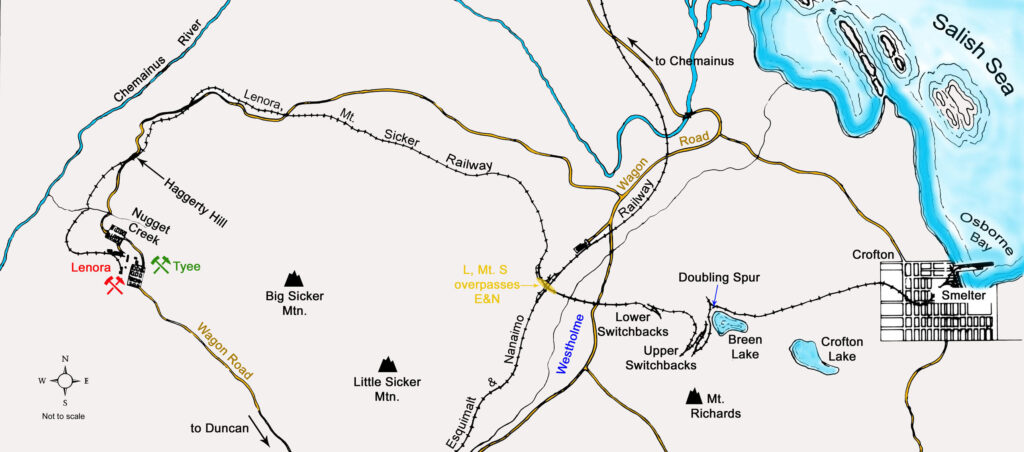The following article “Ghosts of the Grade” is by Tom W. Parkin is a Canadian non-fiction writer living in Nanaimo, British Columbia, who specializes in researching and writing on topics of western history.
The much larger original story, which ran in the magazine Branchline, is about the long-defunct Lenora, Mt. Sicker Railway between Mt. Sicker and Crofton, BC, and is a culmination of several years of bush-whacking and metal-detecting.

Tom Parkin metal-detecting along the supporting stone walls of Mt. Richards. Photo © R Beaumont.

A segment of narrow-gauge track reconstructed within Eves Provincial Park, Westholme. Photo © TW Parkin.

Always obtain permission if walking on private property. Map © Maynard Atkinson.
Ghosts of the Grade
by Tom W. Parkin
The shattering sound of their exhausts echoing from the sheer rock bluffs and the sight of their billowing plumes of black smoke as the little Shays snaked along the switchbacks, their flanges squealing a protest at the sharpness of the curves on their iron trail must have etched deeply into the memory of those fortunate few who lived in the Westholme valley in that era.
Shays on the Switchbacks
Elwood White and David Wilke, 1973
The Lenora, Mount Sicker Railway (LMSR) of Vancouver Island holds a unique place in our region’s history, combining the charm of a narrow-gauge railway with the intrigue of its mining past. This railway was crucial for transporting copper ore from the Lenora mine on Mount Sicker to distant smelters. Its story is marked by innovation, challenges, and the indomitable spirit of those involved.
The LMSR’s history began in 1899 when copper ore was discovered on Mount Sicker, midway between Chemainus and Duncan. Henry Croft, a seasoned project manager and mining engineer, led the development of the mine. To transport the ore, initially, teams of horses and wooden tramways were employed, but they couldn’t keep up with production. Croft’s next move was to implement a three-foot narrow-gauge railway. It followed a similar route as the tramway, but the steep grade and sharp curves required unusual, geared Shay locomotives. As operations progressed, the mountain population grew, and a sawmill supported the building boom.
However, financial and transportation conflicts arose, forcing Croft to extend the railway to tidewater and build a new town called Crofton. To navigate the challenging terrain, the railway featured a dramatic series of six switchbacks on the slope of Mount Richards which are still visible today.
The rail route’s western segment, from Lenora Mine to Westholme, stretched for six miles and began in a “cup” described by a reporter from Victoria’s Daily Times, nestled under the Lenora and Tyee mines. Today, the ghost town of Mount Sicker shows few visible remnants of this once-thriving area. However, mineral collectors and metal detectorists may still find intriguing pieces.
The eastern segment, from Westholme to Crofton, extended for 5.25 miles, and it was known for its breathtaking switchbacks on the slopes of Mount Richards. While the railway is no longer in operation, its legacy lives on, providing a fascinating glimpse into the past. A segment of the route and of the track has be recreated within Eves Provincial Park, where an interpretive sign also pays tribute to the railway.
For those interested in exploring the LMSR today, portions of the old railbed can still be found and hiked. The western segment is easily accessed from Robert Street or Shasta Road in Crofton, plus in Eves Provincial Park. My own metal finds near Crofton include miniature spikes, small hand tools, and a rail “fishplate”, or joint bar.
The LMSR’s story is a unique blend of innovation, engineering challenges, and the ambitious spirit of the people involved. Despite the railway’s premature closure, its legacy endures as an intriguing piece of BC history. It’s a journey well worth taking for hikers, historians, and rail enthusiasts who want to step back in time and explore the remnants of this remarkable narrow-gauge railway.
* * *
A much longer version of this story by author Parkin can be found in Branchline, the member magazine of the Bytown Railway Society, Ottawa. It can be read in the July/August 2023 issue and ordered here: https://bytownrailwaysociety.ca/index.php/branchline. Or you may contact Nanaimo author Parkin through his website: https://tomwparkin.com/contact.


